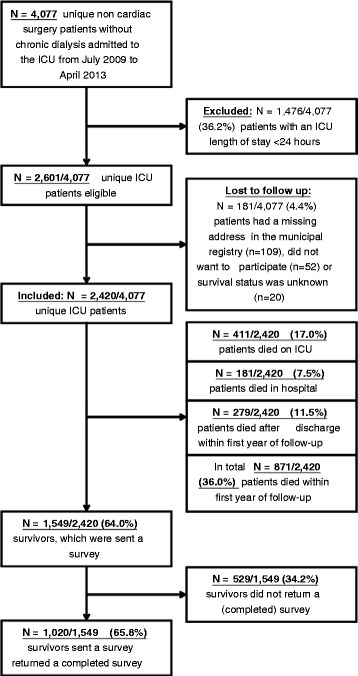The predictive value of early acute kidney injury for long-term survival and quality of life of critically ill patients
- PMID: 27488839
- PMCID: PMC4973091
- DOI: 10.1186/s13054-016-1416-0
The predictive value of early acute kidney injury for long-term survival and quality of life of critically ill patients
Abstract
Background: Prognostic factors for the combination of long-term survival and health-related quality of life (HRQoL) after intensive care unit (ICU) stay have not yet been studied. Our aim was to assess whether early acute kidney injury (eAKI), AKI occurring on the first day of ICU admission, is an independent predictor of this combined one-year outcome.
Methods: We included all patients admitted to the mixed ICU of the University Medical Centre Utrecht between July 2009 and April 2013, excluding patients with chronic dialysis, cardiac surgery, and length of stay shorter than 24 hours. eAKI was defined using the risk, injury, failure, loss, end-stage renal failure (RIFLE) classification, using a newly developed algorithm to classify AKI based on routinely collected patient data. In one-year survivors, HRQoL was measured using the EuroQoL 5D-3L™ (EQ-5D) questionnaire. The primary outcome measure was "poor outcome", defined as an EQ-5D index score <0.4 or death after one year follow up. A multivariable Poisson regression model was performed to adjust for age, comorbidities, admission type and severity of disease factors.
Results: We enrolled 2,420 patients, of whom 871 (36.0 %) died within one year. An additional 286 of 1549 one-year survivors (11.8 %) experienced low HRQoL. The respective incidence of the RIFLE classes, risk, injury and failure, were 456 (18.8 %), 253 (10.5 %) and 123 (5.1 %). After adjustment for other covariates, the RIFLE classes, injury and failure, were independently associated with poor outcome (adjusted relative risk 1.14, 95 % CI 1.01, 1.29; p = 0.03, and 1.25, 95 % CI 1.01, 1.55; p = 0.04), when compared to no eAKI patients . The constituents of this composite outcome were also analysed separately. In a Cox regression model the RIFLE classes, injury and failure, were significantly associated with mortality (adjusted hazard ratio 1.35, 95 % CI 1.11, 1.65; p <0.01, and 1.78, 95 % CI 1.38, 2.30; p <0.01). In one-year survivors specifically, none of the RIFLE classes were significantly associated with low HRQoL.
Conclusions: ICU patients with moderate or severe AKI during the first 24 hours have a higher probability of mortality or low HRQoL (combined poor outcome), one year after ICU admission. Together with other available early prognostic factors, information on early acute kidney injury could improve informed decision-making on the continuation or withdrawal of treatment in ICU patients.
Keywords: AKI; Acute kidney injury; Critical care; HRQoL; Health related quality of life; Intensive care; Long-term; Outcome; Prognosis.
Similar articles
-
The association of acute kidney injury in the critically ill and postdischarge outcomes: a cohort study*.Crit Care Med. 2015 Feb;43(2):354-64. doi: 10.1097/CCM.0000000000000706. Crit Care Med. 2015. PMID: 25474534
-
Early recovery status and outcomes after sepsis-associated acute kidney injury in critically ill patients.Zhong Nan Da Xue Xue Bao Yi Xue Ban. 2022 May 28;47(5):535-545. doi: 10.11817/j.issn.1672-7347.2022.210368. Zhong Nan Da Xue Xue Bao Yi Xue Ban. 2022. PMID: 35753723 Free PMC article.
-
Hypoalbuminemia: a risk factor for acute kidney injury development and progression to chronic kidney disease in critically ill patients.Int Urol Nephrol. 2017 Feb;49(2):295-302. doi: 10.1007/s11255-016-1453-2. Epub 2016 Nov 5. Int Urol Nephrol. 2017. PMID: 27817055
-
The RIFLE versus AKIN classification for incidence and mortality of acute kidney injury in critical ill patients: A meta-analysis.Sci Rep. 2015 Dec 7;5:17917. doi: 10.1038/srep17917. Sci Rep. 2015. PMID: 26639440 Free PMC article.
-
Incidence, timing and outcome of AKI in critically ill patients varies with the definition used and the addition of urine output criteria.BMC Nephrol. 2017 Feb 20;18(1):70. doi: 10.1186/s12882-017-0487-8. BMC Nephrol. 2017. PMID: 28219327 Free PMC article. Review.
Cited by
-
The association of premorbid conditions with 6-month mortality in acutely admitted ICU patients over 80 years.Ann Intensive Care. 2024 Mar 30;14(1):46. doi: 10.1186/s13613-024-01246-w. Ann Intensive Care. 2024. PMID: 38555336 Free PMC article.
-
Long-term outcomes after extracorporeal membrane oxygenation in patients with dialysis-requiring acute kidney injury: A cohort study.PLoS One. 2019 Mar 13;14(3):e0212352. doi: 10.1371/journal.pone.0212352. eCollection 2019. PLoS One. 2019. PMID: 30865662 Free PMC article.
-
Dexmedetomidine alleviates acute kidney injury in a rat model of veno-arterial extracorporeal membrane oxygenation.Intensive Care Med Exp. 2025 Jan 30;13(1):12. doi: 10.1186/s40635-025-00720-4. Intensive Care Med Exp. 2025. PMID: 39884997 Free PMC article.
-
Propensity-score-matched evaluation of under-recognition of acute kidney injury and short-term outcomes.Sci Rep. 2018 Oct 11;8(1):15171. doi: 10.1038/s41598-018-33103-9. Sci Rep. 2018. PMID: 30310097 Free PMC article.
-
Timing of renal replacement therapy initiation for acute kidney injury in critically ill patients: a systematic review of randomized clinical trials with meta-analysis and trial sequential analysis.Crit Care. 2021 Jan 6;25(1):15. doi: 10.1186/s13054-020-03451-y. Crit Care. 2021. PMID: 33407756 Free PMC article.
References
-
- Moreno RP, Metnitz PG, Almeida E, Jordan B, Bauer P, Campos RA, Iapichino G, Edbrooke D, Capuzzo M, Le Gall JR. SAPS 3 Investigators. SAPS-3–From evaluation of the patient to evaluation of the intensive care unit. Part 2: Development of a prognostic model for hospital mortality at ICU-admission. Intensive Care Med. 2005;31(10):1345–55. doi: 10.1007/s00134-005-2763-5. - DOI - PMC - PubMed
-
- Bellomo R, Ronco C, Kellum JA, Mehta RL, Palevsky P, Acute Dialysis Quality Initiative workgroup Acute renal failure - definition, outcome measures, animal models, fluid therapy and information technology needs: the Second International Consensus Conference of the Acute Dialysis Quality Initiative (ADQI) Group. Crit Care. 2004;8(4):R204. doi: 10.1186/cc2872. - DOI - PMC - PubMed
MeSH terms
LinkOut - more resources
Full Text Sources
Other Literature Sources
Miscellaneous


